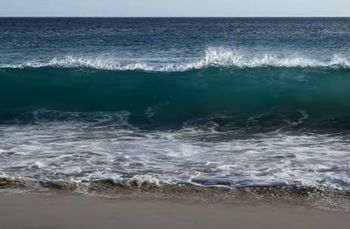Difference between revisions of "Testpage7"
Dronkers J (talk | contribs) |
Dronkers J (talk | contribs) |
||
| Line 2: | Line 2: | ||
Wave breaking video | Wave breaking video | ||
| + | |||
| + | [[File:WavePlunge.jpg|thumb|350px|right|Plunging wave, still from the video]]. | ||
This article presents a video of a '''[https://www.youtube.com/playlist?list=PLV5KQfKi7EFge-1gDEMyPGOlNCEQ9QDNM plunging wave breaking event in slow motion]''', exhibiting all the stages of the [[wave breaking]] process. The original video registration recorded was by Vincentz (2013<ref>Vincentz, 2013. Breaking wave recording https://zenodo.org/records/8070591 under licence CC BY-SA (attribution and share-alike)</ref>). | This article presents a video of a '''[https://www.youtube.com/playlist?list=PLV5KQfKi7EFge-1gDEMyPGOlNCEQ9QDNM plunging wave breaking event in slow motion]''', exhibiting all the stages of the [[wave breaking]] process. The original video registration recorded was by Vincentz (2013<ref>Vincentz, 2013. Breaking wave recording https://zenodo.org/records/8070591 under licence CC BY-SA (attribution and share-alike)</ref>). | ||
Revision as of 11:59, 23 February 2024
Wave breaking video
This article presents a video of a plunging wave breaking event in slow motion, exhibiting all the stages of the wave breaking process. The original video registration recorded was by Vincentz (2013[1]). It distributes the sequence of images of a single breaker plunging onto a sandy beach on a windless day. It shows remarkably clearly a shoaling wave that steepens suddenly, grows into a sequence of narrowly spaced plunging breakers, and dissolves in spray and foam. Clearly visible is also the sand stirred and suspended in the foreshore and, upon close inspection, that entrained within the curling wave. The recording conveys the dramatic impression of a prototypical plunging wave dissolving explosively in spray and foam on a natural beach. The onset and development of breakers in the shoreface is impressive because of the rapidity, dynamic range, and chaotic and cyclic behaviours embedded in their motion.
Location description
The video was taken on 11 February 2013 at the sandy beach Playa del Matorral in the locality Morro Jable, municipality of Pájara in the island of Fuerteventura, Canary Islands, Spain. The Playa del Matorral faces SSW and SE and thus, roughly speaking, the African coast. The region is tidal: the water-level excursion at the nearby Puerto del Rosario is reported to be 2.3 m at springs and 1.6 m at neaps. The seabed declines fairly steeply, approximately down to -500 m within 2 km or less from the mean sea level line. The development of the plunging breaker is clear evidence that the beach is behaving as a reflective one. Qualitatively, the closeness to the shore of the breaking line, the narrow shoreface, and the collision of backwash and incoming waves are additional indicators of a steep shoreface profile. If present, nearshore sandbars do not appear to affect the breaking process.
Breaker description
The scales of motion interleaved within the mixture of water, sand and air in such a sudden and rapid event become clearer thanks to the slowed-down videos. Although inferences about shoreface features out of view remain somehow speculative, the qualitative details in the recording reveal distinctive stages of development and features:
- Waves shoal with long arrival times, with a single episode of breaking occurring as in an isolated solitary wave, except here the backrush provides feedback to the steepening of the wave. Extrapolating the evidence from the recording, this breaking might actually indicate a small-amplitude swell, or edge wave, with a period of 13-16 seconds;
- There is no extensive surf zone that influences the nearshore zone seaward of the plunge point, and the recording is taken on a windless day;
- The sand stirred and suspended in the foreshore is visible in both the swash and the water raised and curled as the wave breaks;
- The backrush from the previously broken wave has largely returned seawards when a fresh plunger engulfs the foreshore; this emphasises the cycling behaviour expected in a wave, also with regard to the sand motion;
- The breaking does not unfold as a single wave form seamlessly steepening, curling, and collapsing after a single point of instability has been touched. Instead, while advancing over the small plunge distance, the steep wave face spawns new crests of water that surge ahead and leave behind the previous crest, which nonetheless impinges on the back of the leading wave face and break behind. The breaking of this 'single breaker' is, in fact, remarkably composite and nonlinear.
This evidence on a natural beach can usefully be contrasted with the laboratory study of Hafsteinsson et al (2017[2]) that reports systematic observations of spilling, plunging and surging breakers in a narrow channel with a uniform bed slope.
Related articles
References
- ↑ Vincentz, 2013. Breaking wave recording https://zenodo.org/records/8070591 under licence CC BY-SA (attribution and share-alike)
- ↑ Hafsteinsson, H.J., Evers, F.M. and Hager, W.H. 2017. Solitary wave run-up: wave breaking and bore propagation. J. Hydr. Res. 55: 787-798
Please note that others may also have edited the contents of this article.
|
